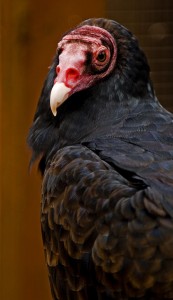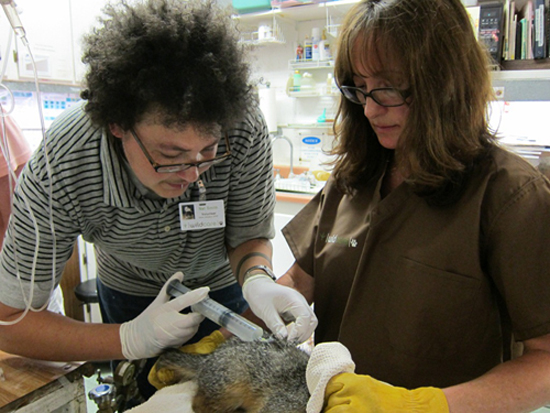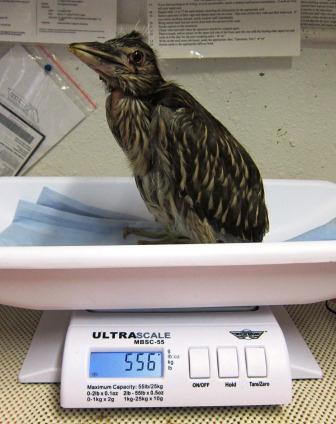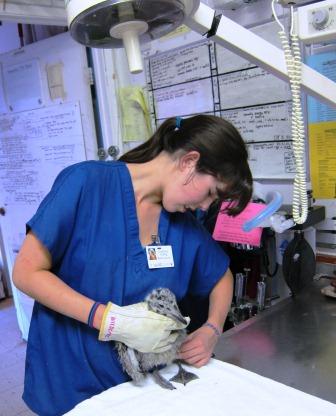A Walk on the Wild Side
Wildlife gets a home and a haven at WildCare in California’s Bay Area
 By Leda Marritz
By Leda Marritz
It is extraordinary to see a turkey vulture really close up. Their white beaks are sculptural and smooth, and their pink nostrils are curved like shells. Black feathers on their head, breast and shoulders give way to plumage with brown edging and blackish spines on their wings, and their eyes are dark and intelligent. Big, scaly feet with wonderfully sharp talons hold them very still and steady.
I’d love to see a turkey vulture this close in the wild. Instead, the one I’ve just met lives in the courtyard of WildCare, a wildlife rehabilitation center in San Rafael, in Northern California’s Marin County. His name is Vlad. (It suits him perfectly!)
The courtyard has over 10 birds and other animals who are healthy but can’t be returned to the wild, so they live in small but well-appointed outdoor habitats. Some of them have been here for over 15 years and are no longer exactly wild anymore, but were injured to the point where they can’t look after themselves, or cannot be released due to federal regulations.
Vlad, for example, imprinted on by a human who “rescued” him from the wild at an early age, and he never learned the skills he needed to survive on his own. Courtyard animals get special state and federal permits as “wildlife ambassadors,” serving to educate the public about wild animals both here and off-site at schools and other educational settings.

At the hospital: a quiet buzz of life force
Livia McRee, the Hospital Manager, has been giving me a tour of the courtyard, the indoor and outdoor wards, offices and educational areas, although they are best known for their wildlife hospital. As you enter, there is a certain quiet purposefulness. The rooms buzz with subdued activity. The collective energy of the staff and their wild patients creates an atmosphere humming with – I’m not sure what else to call it – life force of some kind.
In the first ward, Livia introduces me to a baby wild turkey, a juvenile barn owl, and a young skunk. She explains that WildCare coordinates with other local wildlife agencies to pair young animals of the same species wherever possible. Looking at that baby turkey alone in the incubator, it’s easy to imagine that life would get lonely. Socializing with other members of your own kind is a key part of growing up and being able to survive once they have been returned to the wild.
 Across the room the young barn owl, still a bit fluffy around the edges, bobs and weaves as I pass by, trying to intimidate me. He’s been snacking on some defrosted and bloody baby mice, a pointed reminder that many wild animals survive by eating other animals.
Across the room the young barn owl, still a bit fluffy around the edges, bobs and weaves as I pass by, trying to intimidate me. He’s been snacking on some defrosted and bloody baby mice, a pointed reminder that many wild animals survive by eating other animals.
As we wend our way through the small wards, the staff and volunteers are all in motion, trying to complete their care of the animals and other duties quickly and efficiently, all while minimizing their contact with the animals. It’s important for the animals at WildCare not to become habituated to human care – a healthy wariness of people is critical for them to survive in the wild.
Like any successful agency with limited resources (90 percent of their funding comes from individual donors, and 75 percent of their operating budget is allocated for aid, advocacy, and education programs) WildCare relies on over 300 volunteers who work in either the wildlife hospital or as nature guides. About 40 of them also act as foster homes. (On the day I visited there were over 100 patients in foster care.)
Many of the patients at WildCare have been injured due to conflict with humans. Outdoor cats are some the main culprits, especially during the spring when baby animals are easy cat bait. WildCare urges cat owners to keep their felines inside.
Other animals come in after being hit by cars (often opossums, who move slowly and are active at night), or because they have eaten or gotten tangled in fishing line or hooks. This was the case with a 30-year-old Great Blue Heron, affectionately christened “Nasty Senior” by the folks who knew him. WildCare treated him once years ago for ingesting fishing line, and he came in again recently for the same issue. Unfortunately he did not survive the second time.
In addition to treating over 3,000 sick and injured animals each year in their hospital, WildCare also runs education programs for kids, as well as a wildlife solutions service that uses humane techniques to help minimize conflict between wildlife and humans. These programs aren’t as expansive as the WildCare leadership would like, but they are a critical tool in the evolving relationship between humans and other animals.
Should we or shouldn’t we? The big questions
 The Deepwater Horizon oil gusher is the latest and most ghastly example of the human-wildlife conflicts that can occur as we humans encroach on wild and undeveloped places.
The Deepwater Horizon oil gusher is the latest and most ghastly example of the human-wildlife conflicts that can occur as we humans encroach on wild and undeveloped places.
Some wildlife experts have been saying that rehabilitation efforts are counter-productive and just increase suffering. WildCare takes an entirely different view.
“Every spill is different and has different success rates depending on a variety of factors,” Livia told me. “Organizations like Oiled Wildlife Care Network do amazing research and are constantly improving oiled wildlife care. Great strides have been made over the years. Everyone in our organization absolutely feels that rehabbing oiled wildlife is worth it.” Livia adds that sometimes rehabbing means euthanizing an animal who’s suffering rather than letting nature take its course.
How you and I can help when there’s a catastrophe for wildlife
Ecological catastrophes naturally arouse tremendous amounts of compassion, emotion, and a desire to do something to make a difference. Many people want to volunteer with a local rescue or cleanup effort for the duration of the event, which can make a big difference.
But this desire to help is also critically important all the time, perhaps especially when there is no obvious emergency.
People want to know how to help with the animals in the oil spill. My conclusion after visiting WildCare: offer help to your own local wildlife rehabilitation agencies. One positive outcome of an ecological disaster like this is that it can serve as a meaningful entry point for people to become aware of and involved in wildlife rehabilitation and preservation efforts. Teaching and supporting values and behaviors that promote humane cohabitation with wildlife is one of the overarching challenges that animal welfare agencies, rehabilitators and conservationists face. How we choose to meet that challenge will be our legacy.
Resources:
Volunteer at WildCare
Expert answers on living with wildlife and humane wildlife solutions
Locate a wildlife rehabber near you
